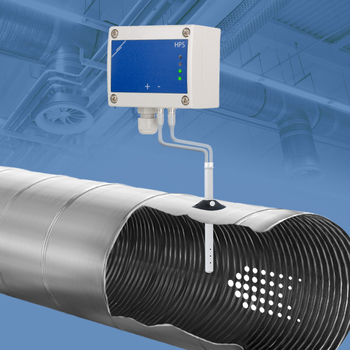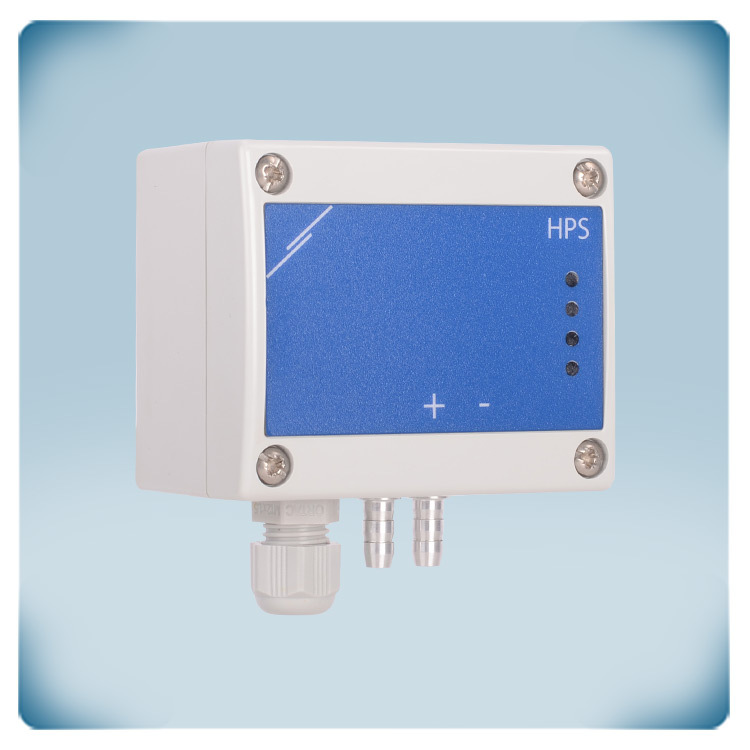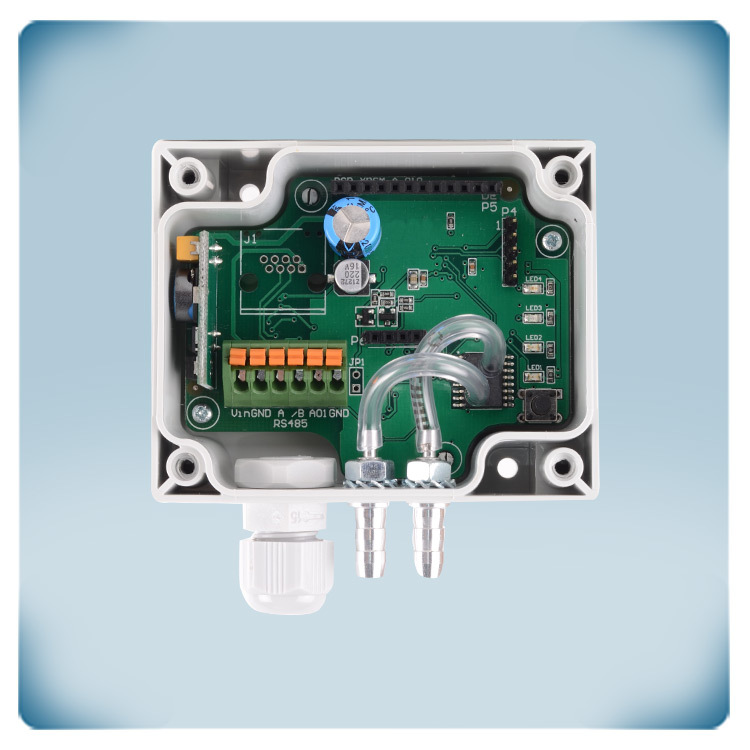EU declaration conformity
Differential pressure transmitter | -125 to +125 Pa | 24 VDC
Product description
This HVAC sensor is designed for measuring differential pressure within the range of -125 to +125 Pa and operates with a supply voltage of 24 VDC. Additionally, this sensor has the capability to measure air volume flow or air velocity.
The measured value is accessible through both the analogue output and Modbus RTU communication. The output type is selectable (0—10 VDC, 0—20 mA or 0—100 % PWM) and the sensor status along with measured values are visually indicated by four LED indicators.
The differential pressure range and all other settings can be adjusted via Modbus RTU.
Documents
Additional specifications and description
Differential pressure, air volume flow or air velocity?
This sensor measures differential pressure [Pa]. Based on this measurement, air volume flow [m³/hr] or air velocity [m/s] can be calculated. To calculate air volume flow based on the K-factor of the fan, use the connection set type PSET-PVC-200 or PSET-QF-200. This optional connection set can also be used to measure differential pressure. To calculate air volume flow based on the duct cross section [cm²] or air velocity [m/s], use the optional connection set type PSET-PTS-200 or PSET-PTL-200.
This sensor measures differential pressure [Pa]. Based on this measurement, air volume flow [m³/hr] or air velocity [m/s] can be calculated. To calculate air volume flow based on the K-factor of the fan, use the connection set type PSET-PVC-200 or PSET-QF-200. This optional connection set can also be used to measure differential pressure. To calculate air volume flow based on the duct cross section [cm²] or air velocity [m/s], use the optional connection set type PSET-PTS-200 or PSET-PTL-200.

Visual indication
This pressure transmitter offers a clear, visual indication of the differential pressure level via the green, yellow and red LED. The green LED indicates that the pressure level is within range. When the pressure level enters the alert range, the yellow LED lights up. Red means: differential pressure out of range. The LEDs can also indicate the status of the air volume flow or air velocity. The second green LED indicates the sensor status. It is activated when power supply and Modbus RTU communication are enabled.
This pressure transmitter offers a clear, visual indication of the differential pressure level via the green, yellow and red LED. The green LED indicates that the pressure level is within range. When the pressure level enters the alert range, the yellow LED lights up. Red means: differential pressure out of range. The LEDs can also indicate the status of the air volume flow or air velocity. The second green LED indicates the sensor status. It is activated when power supply and Modbus RTU communication are enabled.
How does it work?
This sensor has one analogue output. It transmits the measured differential pressure, air volume flow or air velocity proportionally. The default range of this sensor is -125 to +125 Pa. By default, the output transmits 0 V at -125 Pa and 10 V at +125 Pa. This range, the output type and all other settings can be adjusted via Modbus RTU. The output type can be adjusted via Modbus RTU: 0-10 VDC / 0-20 mA / 0-100 % PWM.
This sensor has one analogue output. It transmits the measured differential pressure, air volume flow or air velocity proportionally. The default range of this sensor is -125 to +125 Pa. By default, the output transmits 0 V at -125 Pa and 10 V at +125 Pa. This range, the output type and all other settings can be adjusted via Modbus RTU. The output type can be adjusted via Modbus RTU: 0-10 VDC / 0-20 mA / 0-100 % PWM.
Reduced installation time
The supply voltage, the analogue output and Modbus RTU communication can be connected via the cage clamp terminal block. They eliminate the need for routine maintenance and guarantee a reliable contact for solid or stranded wires. The supply voltage is 24 VDC. The ground terminals of the power supply (V-) and output (GND) are internally not connected. This means that a 4-wire cable is required to connect this sensor. Most 24 VDC power supplies offer protection against short circuit, overload and overvoltage. A 24 VDC supply voltage increases the safety and reliability of your installation
The supply voltage, the analogue output and Modbus RTU communication can be connected via the cage clamp terminal block. They eliminate the need for routine maintenance and guarantee a reliable contact for solid or stranded wires. The supply voltage is 24 VDC. The ground terminals of the power supply (V-) and output (GND) are internally not connected. This means that a 4-wire cable is required to connect this sensor. Most 24 VDC power supplies offer protection against short circuit, overload and overvoltage. A 24 VDC supply voltage increases the safety and reliability of your installation
High quality
The enclosure is made of high-quality r-ABS VO (UL94) plastic. This material is heat resistant, very tough and offers good protection against impacts. The pressure connection nozzles are made from aluminium. The sensor enclosure offers an IP65 protection against ingress of dirt and water. This sensor can be wall-mounted.
The enclosure is made of high-quality r-ABS VO (UL94) plastic. This material is heat resistant, very tough and offers good protection against impacts. The pressure connection nozzles are made from aluminium. The sensor enclosure offers an IP65 protection against ingress of dirt and water. This sensor can be wall-mounted.
Monitor overpressure in staircases
A typical application for differential pressure sensors with this range is to monitor underpressure or overpressure in staircases or cleanrooms. For instance, by creating a constant overpressure in the staircase, it remains smoke-free in case of fire.







.webp)
.webp)
.webp)
.webp)
.webp)
.webp)






Remarks, reviews & ratings